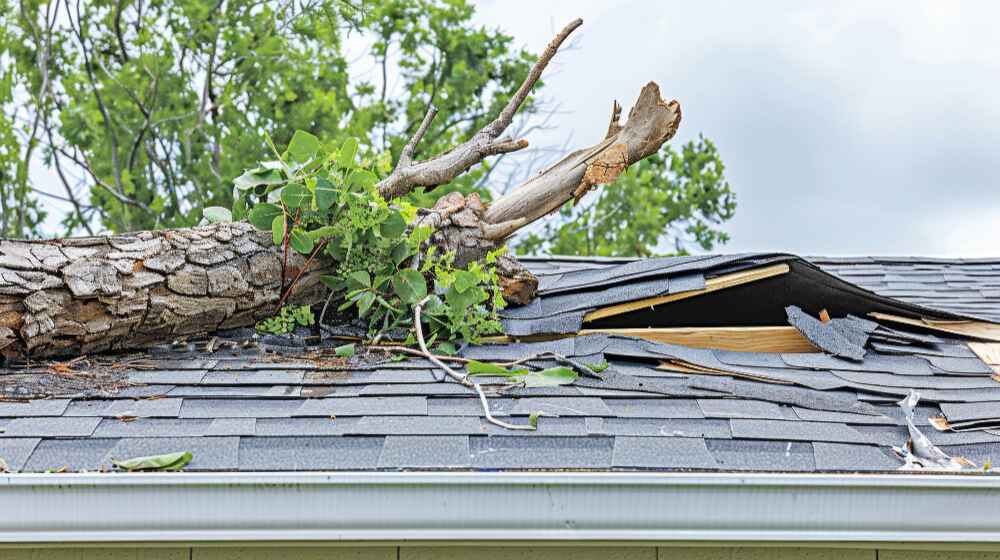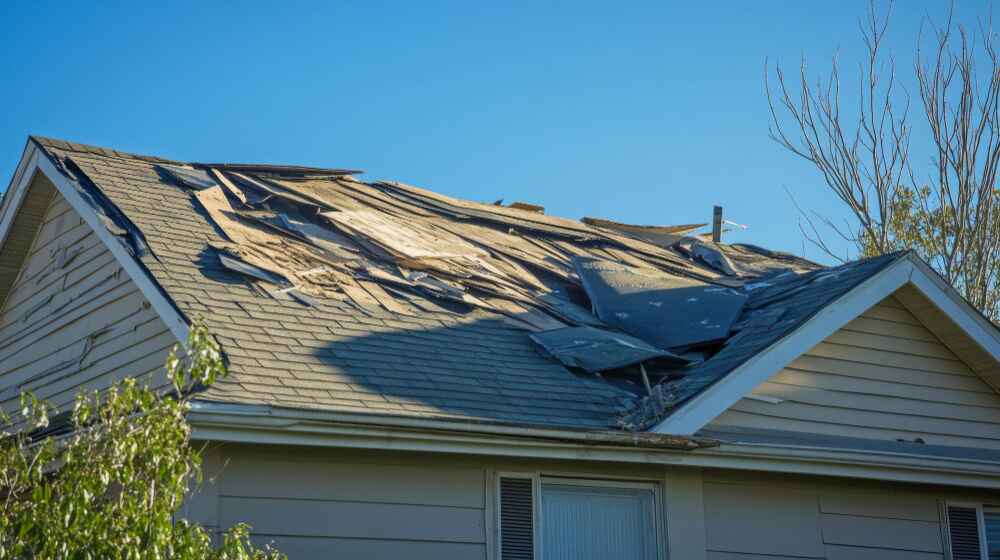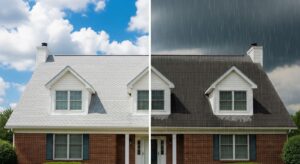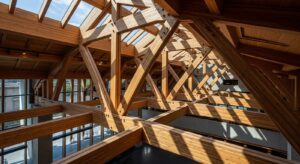When the wind howls and the skies darken, most of us head indoors, trusting our roof to keep the elements at bay. However, wind damage roof shingles can compromise this protection, often without homeowners even noticing. Wind damage to roof shingles is one of the sneakiest threats to your home. It can seem small at first, but if left unchecked, it can spiral into major leaks, structural damage, and costly repairs.
In this post, we’ll break down everything you need to know about wind damage to shingles, including what it looks like, how much wind a roof can handle, how to fix damage, and how to prevent it in the future. Whether you’ve just been through a storm or you’re planning ahead, let’s dive into what every smart homeowner should know.
What Does Wind Damage Look Like on a Roof?
High winds don’t just make noise—they can physically lift, crack, or remove shingles entirely. The result? Vulnerable spots where water can get in and wreak havoc.
Key Signs of Wind-Damaged Shingles:
- Missing Shingles: Obvious, but often overlooked. A bare spot on your roof means water can slip right in.
- Lifted or Curled Edges: Shingles no longer lie flat, leaving seams open to wind-driven rain.
- Creases or Tears: Especially on older asphalt shingles. They might look fine from afar but have subtle cracks.
- Granule Loss: If your gutters are full of tiny shingle particles, that’s a red flag.
- Interior Water Stains: Discoloration on ceilings or attic beams means water’s already gotten through.
Pro Tip: After a windstorm, walk around your property (safely!) and inspect the roof from ground level with binoculars or use a drone. Catching damage early could save you thousands.
Let’s dive in and help you stay ahead of costly repairs and unexpected drips. Read our most common roof repair issues blog.
What Causes Wind Damage to Roof Shingles?
Many cases of wind damage roof shingles stem from a combination of aging materials and poor installation. Let’s unpack it.
How Wind Uplift Works:
As wind rushes over your roof, it creates pressure differences. Lower pressure on the top and higher pressure inside your attic causes a suction effect. The result? Shingles can lift and peel away from their adhesive backing.
Common Vulnerabilities:
- Old or Brittle Shingles: Age weakens the shingle’s flexibility and bond strength.
- Improper Installation: Skipped nails, weak adhesive strips, or poor alignment make it easier for wind to pry them off.
- Roof Design: Low-pitch or flat roofs often catch wind like a sail.
- Previous Damage: Already-compromised shingles are low-hanging fruit for the wind.
Prevention starts with quality installation and material choices—but more on that below.
How Much Wind Can a Roof Withstand?
Great question! It depends on the materials, the age of your roof, and the installation quality.
Average Wind Resistance by Shingle Type:
- 3-Tab Asphalt Shingles: Typically rated for up to 60-70 mph winds.
- Architectural (Dimensional) Shingles: These hold strong at 110-130 mph.
- High-Impact or Premium Shingles: Some are engineered for up to 150+ mph, common in hurricane zones.
Building Code Considerations:
Areas like Florida or coastal Texas have stricter requirements. Local codes may mandate shingles meet higher wind resistance standards (like ASTM D3161 Class F or ASTM D7158 Class H).
Want long-term peace of mind? Invest in shingles designed for your climate. Malarkey Shingles Reviews
How to Repair Wind-Damaged Shingles

Not all wind damage means full roof replacement. But the sooner you act, the better.
Temporary Fixes:
- Roofing Cement: Good for sealing small tears or lifted edges temporarily.
- Roof Tape or Tarping: If rain is coming and your roofer can’t make it right away, cover the area.
Permanent Repairs:
- Shingle Replacement: Pull out the damaged shingle and replace it with a match. Be sure to seal the nail heads.
- Flashing Repair: Wind often lifts flashing around chimneys and vents. These should be re-secured or replaced.
When to Call a Pro:
- More than a handful of shingles are damaged
- You see signs of leaks or water damage inside
- You’re unsure how extensive the damage is
Insurance Considerations for Wind Damage
Wind damage is often covered by homeowners’ insurance, but the process can be tricky.
Steps to Take:
- Document Everything: Take clear, timestamped photos of all visible damage.
- Secure the Area: Prevent further damage with tarps or temporary seals.
- Call Your Insurer: File a claim and request an adjuster visit.
- Get Estimates: Obtain a quote from a licensed roofer (your insurance may require multiple).
- Coordinate the Repair: Your roofer and insurer can often work together to ensure everything gets approved.
Learn more about Roof Damage Insurance Claim Process.
How to Prevent Wind Damage on Your Roof
The best defense is a smart offense. Here’s how to stay ahead of the wind.
Regular Maintenance:
- Schedule bi-annual inspections using a trusted roof inspection checklist from NRCA or consult a local contractor.
- Clean out gutters to prevent water backup.
- Trim back overhanging trees.
- Replace damaged or loose shingles immediately.
Upgrade Your Roof:
- Reinforced Shingles: Malarkey and other premium brands offer wind-rated products.
- Proper Installation: Always hire certified professionals who know local wind codes.
- Underlayment & Fasteners: A quality underlayment and ring-shank nails provide better wind resistance.
FAQs About Wind Damage Roof Shingles
Can I Repair a Few Wind-Damaged Shingles Myself?
Yes, but only if you’re comfortable with heights and roofing tools. Always prioritize safety and check your warranty before attempting to repair wind damage roof shingles on your own. When in doubt, call a professional roofer.
How Do I Know If Wind Damage Is Serious?
If more than 5–10 shingles are missing or damaged, if flashing is bent or missing, or if you notice water intrusion in your attic or ceilings, your roof has serious wind damage and should be inspected immediately.
Will Insurance Cover Minor Wind Damage?
Often yes, especially if it’s well documented. Homeowners’ insurance generally covers wind damage to roof shingles, but check your policy and act quickly after a storm to avoid claim denial.
Are Certain Roof Shapes More Vulnerable to Wind?
Yes. Gable roofs and flat roofs are more prone to wind uplift compared to hip roofs, which distribute wind pressure better. Roof shape, materials, and installation quality all affect your roof’s wind resistance.
Final Thoughts: Stay One Step Ahead of the Storm
Wind may be invisible, but its impact on your roof is anything but. By understanding what wind damage roof shingles look like, how the damage happens, and how to fix it, you’re already ahead of 90% of homeowners. Don’t wait until you’re mopping up a leak in the middle of the night.
Be proactive. Book regular inspections. Choose wind-rated materials. And when the next storm blows through? You can rest easy knowing your roof is ready.
Need a professional inspection or urgent repair? [Contact our roofing experts today] and let’s make sure your home stays protected no matter the forecast.






